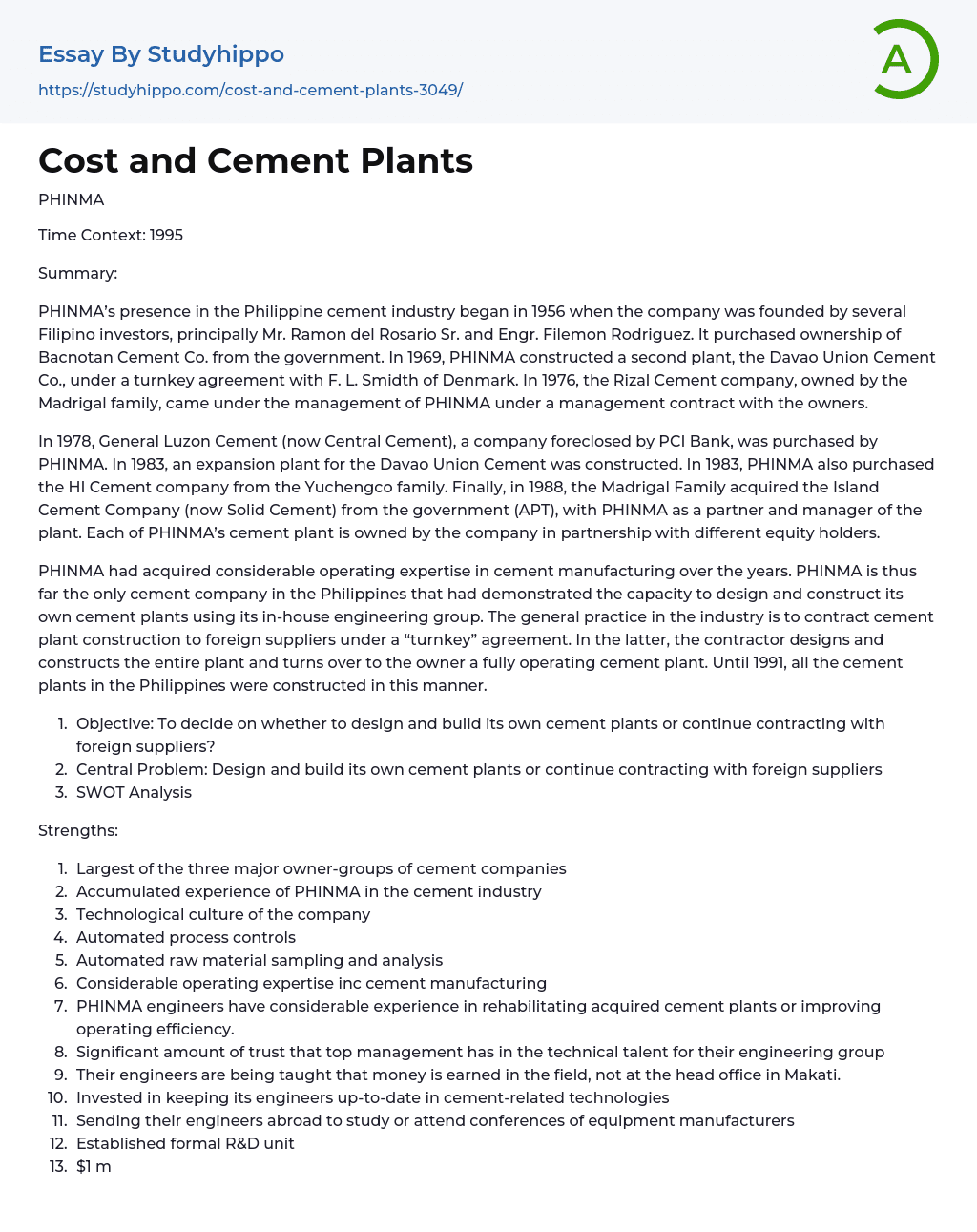

SWOT Analysis PHINMA: Cost and Cement Plants Essay Example
PHINMA’s presence in the Philippine cement industry began in 1956 when the company was founded by several Filipino investors, principally Mr. Ramon del Rosario Sr. and Engr. Filemon Rodriguez. It purchased ownership of Bacnotan Cement Co. from the government. In 1969, PHINMA constructed a second plant, the Davao Union Cement Co., under a turnkey agreement with F. L. Smidth of Denmark. In 1976, the Rizal Cement company, owned by the Madrigal family, came under the management of PHINMA under a management contract with the owners.
In 1978, General Luzon Cement (now Central Cement), a company foreclosed by PCI Bank, was purchased by PHINMA. In 1983, an expansion plant for the Davao Union Cement was constructed. In 1983, PHINMA also purchased the HI Cement company from the Yuchengco family. Finally, in 1988, the Madrigal Family acquired the Island Cement Company (now Solid Cement) from the government (AP
...T), with PHINMA as a partner and manager of the plant. Each of PHINMA’s cement plant is owned by the company in partnership with different equity holders.
PHINMA had acquired considerable operating expertise in cement manufacturing over the years. PHINMA is thus far the only cement company in the Philippines that had demonstrated the capacity to design and construct its own cement plants using its in-house engineering group. The general practice in the industry is to contract cement plant construction to foreign suppliers under a “turnkey” agreement. In the latter, the contractor designs and constructs the entire plant and turns over to the owner a fully operating cement plant. Until 1991, all the cement plants in the Philippines were constructed in this manner.
SWOT Analysis
Strengths:
- Largest of the three major owner-groups of cemen
companies
Weaknesses:
- High energy costs
- Capital costs of conversion are high
- Cement plant requires a large financial investment currently ranging from $150-$200 million.
- P100 million worth of mistakes
- Government abetted
- Less efficient then Korean investors
Opportunities:
- Expansion plant to reduce cost
- When a cement plant is efficiently constructed, the savings in plant construction cost translate into lower depreciation costs.
- Growth in domestic cement demand
- Non-engineers plant managers but with managerial skill
- Inviting foreign technical consultants
- Monopolize the industry
- Gain better control of their technology by fabricating some of the heavier pieces of equipment and castings currently being imported
- Compete with Vietnam and South China
Threats:
- Thai cement producers
- Koreans investing in cement in the Philippines
- Government regulations
- Overcapacity exceeding local demand
- Oil crisis
- Cement shortage due to rising demand
Alternative Courses of Action
Design and build its own cement plants
- Advantages: a. They will be able to save up to 20% b. They can choose the kind of equipment they like c.
Less expensive d. 50% local content
Continue having turnkey agreement with foreign suppliers
- Advantage: a. More automated processes b. Better equipment sourcing c. Capacity to manufacture some of the major pieces of the cement equipment.
- Disadvantage: a. More expensive b. Adds around 20 percent to the cost c. Only 25% value would be local
Strategy Formulation
I conclude that the best solution to the problem is alternative no. which is to design and build its own cement plants because it will give pride to our country plus the company can save a lot compared to having an agreement with foreign suppliers.
Plan of Action
- Continue organizing conferences for their engineers to learn more
- Expansion plants to reduce cost
- Hire non-engineers but with managerial skills
- Develop their R&D unit
Potential Problems
- What if Korean investors will pursue their plan to invest here in the Philippines?
- What if there are no more qualified engineers to be hired?
- What if there will be oversupply of their product?
Contingency Plans
- As they have said, they are still ahead even if they are less efficient because Koreans will be having higher costs than them. They should be precautious but then be confident enough and be proud of their locally-own made product.
- Train people with the capability of being a part of their company. Allot budget for those to study abroad and learn a lot.
- They should cope with the demand of the consumers. They should be aware how much is the demand so as for them to know how many they should produce.
- Auction essays
- Balanced Scorecard essays
- Business Plans essays
- Expense essays
- Income essays
- Net Income essays
- Security Guard essays
- Singapore Airlines essays
- Battle essays
- Intranet essays
- Maintenance essays
- Simulation essays
- Inn essays
- Chief Executive Officer essays
- Convenience Store essays
- Firm essays
- Training And Development essays
- Unilever essays
- Variable Cost essays
- Virgin Group essays
- Bargaining essays
- Entity essays
- Pest analysis essays
- Leadership and Management essays
- Change Management essays
- Project Management essays
- Knowledge Management essays
- Operations Management essays
- Quality Management essays
- Risk Management essays
- Scientific Management essays
- supply chain management essays
- Performance Management essays
- Time Management essays
- Brand Management essays
- Total Quality Management essays
- Risk essays
- Manager essays
- Leadership essays
- Business Ethics essays
- Board Of Directors essays
- Product Management essays
- Comparative Analysis essays
- Decision Making essays
- Dispute Resolution essays
- Stress Management essays
- Business Management essays
- Brand Equity essays
- Branding essays
- Nike, Inc. essays



